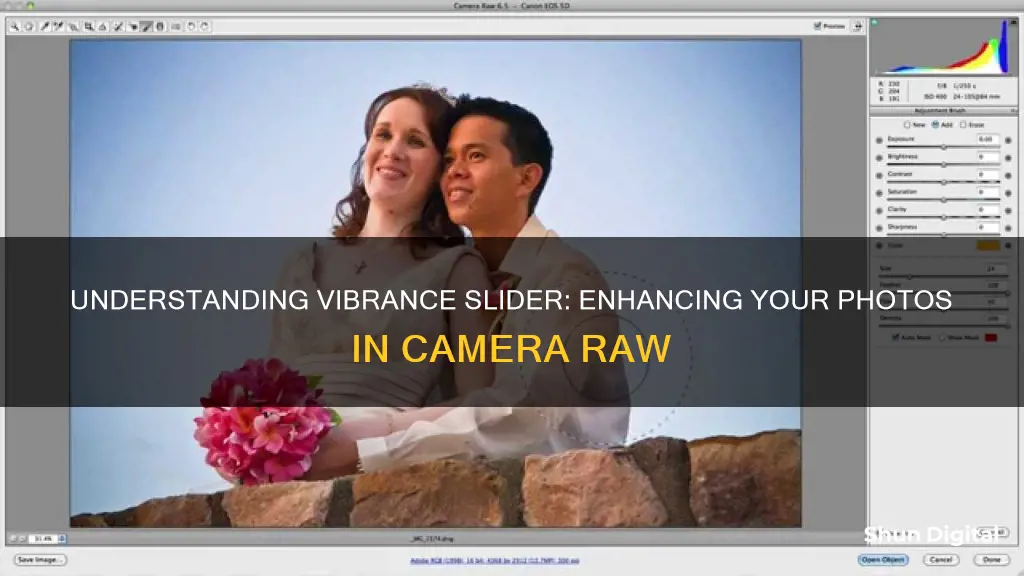
Adobe Camera Raw is a powerful tool for editing and enhancing raw image files. It offers a range of adjustments and modifications, including the ability to change exposure, brightness, clarity, and colour saturation and vibrance. The Vibrance slider is particularly interesting as it intensifies colours more selectively than the Saturation slider. Vibrance boosts colours that are more muted and mostly ignores warmer colours like reds, oranges, and yellows, while prioritising cooler colours like blues and greens. This makes it ideal for photos with people as it prevents skin tones from becoming oversaturated.
| Characteristics | Values |
|---|---|
| Adjusts the saturation | +100 (pure monochrome) to +100 (double the saturation) |
| Boosts muted colours | --- |
| Ignores warmer colours | --- |
| Prioritises cooler colours | --- |
| Avoids increasing flesh tones | --- |
| Minimises clipping | --- |
What You'll Learn

Vibrance boosts muted colours
Vibrance is often referred to as "smart saturation" because it boosts muted colours in a photo more selectively. It does so by intensifying colours but focusing on cooler colours like blues and greens, while mostly ignoring warmer colours like reds, oranges, and yellows. This means that when you increase the vibrance, colours that are already vibrant are affected less than the dull colours.
Vibrance is a useful tool when editing portraits because it prevents oversaturated skin tones. This is why portrait photographers prefer using vibrance over saturation, especially when people are in the frame.
When using the vibrance tool with scenery, more vibrance can be a good thing. However, when using it on people, less is more. Small adjustments to the Vibrance slider are better.
In Adobe Photoshop Camera Raw, the Vibrance slider targets the less saturated colours, increasing their saturation while leaving already saturated colours relatively untouched. This ensures that colours do not become overly saturated and maintains a more natural look, especially for skin tones.
Wireless Camera Battery Life: How Long Do They Last?
You may want to see also

Vibrance prioritises cooler colours
Vibrance is a powerful tool in Adobe Photoshop and Lightroom that enhances the colours in images. It is often referred to as "smart saturation" because it boosts the intensity of colours more selectively than the Saturation slider. Specifically, vibrance prioritises cooler colours, such as blues and greens, while muting warmer colours like reds, oranges and yellows. This makes it particularly useful for portraits, as it enhances colours without creating unnatural, oversaturated skin tones.
The selective nature of the Vibrance slider is what sets it apart from Saturation. When you increase Saturation, all colours across the entire tonal range are affected, from shadows to highlights. This can result in an image that appears overly bright and gaudy, like a cartoon. On the other hand, Vibrance targets only the midtone colours, boosting colours that are more muted. This means that you can increase the vibrance in an image without affecting the overall colour balance.
The Vibrance slider is ideal for enhancing portraits and images with people because it preserves skin tones. When editing a portrait, increasing the vibrance can add a subtle pop of colour while maintaining a natural look. This is because the Vibrance slider avoids increasing the intensity of skin tones, resulting in a more pleasing image.
In addition, Vibrance is useful when you want to enhance subtle landscapes or flower images. For example, if you want to add a bit of vibrance to a landscape image while keeping the intensity low, the Vibrance slider is a good choice. It allows you to boost the cooler colours without oversaturating the warmer colours, creating a more balanced and natural-looking image.
By understanding the differences between Saturation and Vibrance, photographers can make informed decisions about when to use each tool. While Saturation is useful for making images pop, Vibrance is ideal for fine-tuning skin tones and muted colours, resulting in a more subtle and natural enhancement.
Space Tesla Camera: Did the Battery Die?
You may want to see also

Vibrance prevents skin tones from becoming oversaturated
Vibrance is a smart tool invented by Adobe for more precise colour editing. It increases the intensity of colours that are muted and less saturated, while leaving fully saturated colours untouched. This results in images that appear more natural and even.
Vibrance is particularly useful for photographers who are shooting portraits or fashion, as it prevents skin tones from becoming oversaturated. This is because it has a special mathematical algorithm that avoids increasing any flesh tones.
When you increase the saturation slider, all the colours across the entire tonal range will be affected, from shadows to highlights. This can lead to an image that looks garish and unpleasant, especially when people are in the frame.
Saturation affects all pixels, whereas vibrance only adjusts the less dominant colours. This means that when you increase the vibrance slider, it only makes dull colours in the image more vibrant and colourful. It senses which colours are already vibrant and affects these less than the dull colours.
Therefore, when editing portraits, it is recommended to increase the vibrance slider rather than the saturation slider. This will enhance the image while keeping skin tones natural.
Sharpening Images: Adobe Camera Raw's Powerful Tools
You may want to see also

Vibrance slider is great for photos with people
The Vibrance slider in Camera Raw is an incredibly useful tool for enhancing your photos, especially when they feature people. This is because it boosts the intensity of colours in your image while preserving natural skin tones.
Vibrance is often referred to as "smart saturation" because it intensifies colours more selectively than the Saturation slider. While Saturation increases the intensity of all colours in an image, Vibrance targets less vibrant, muted colours, boosting their intensity without affecting colours that are already vibrant. This makes it perfect for photos with people, as it enhances colours without altering skin tones.
The Vibrance slider also tends to focus on cooler colours, such as blues and greens, while mostly ignoring warmer colours like reds, oranges, and yellows. This is ideal for portraits, as it prevents skin tones from becoming oversaturated and unnatural. By using Vibrance, you can make colours pop without affecting the natural look of your subject's skin.
When editing photos with people in them, it's best to use Vibrance subtly. Start with small adjustments and gradually increase the effect until you find the right balance. Remember, a little goes a long way with the Vibrance slider.
Additionally, you can use Vibrance for more subtle landscape and flower images. It's a great way to add a bit of extra colour while maintaining a natural look. Just be sure to apply it carefully and adjust the slider in small increments to avoid overdoing it.
By understanding the differences between Saturation and Vibrance, you can make better-informed decisions about when to use each tool. While Saturation is excellent for boosting colours in landscapes or images without people, Vibrance shines when it comes to portraits and images featuring people, as it preserves the natural look of skin tones while enhancing the overall colour of your image.
Camera Battery Explosions: How Common Are They?
You may want to see also

Vibrance is useful for subtle landscapes
Vibrance is a useful tool for enhancing the colours in subtle landscapes. While the saturation slider affects all the colours in an image, vibrance targets only the mid-tone colours. This means that when editing more muted landscapes, vibrance can be used to add a "pop" of colour without making the image look garish or oversaturated.
Vibrance boosts colours that are more muted, and it mostly ignores warmer colours (yellows, oranges and reds) while prioritising cooler colours (blues and greens). This is why portrait photographers often use vibrance, as it prevents oversaturated skin tones.
Vibrance is also useful for landscapes as it can add a subtle brightness without a lot of intensity. It enhances the dull parts of an image. When editing landscapes, it is recommended to use the vibrance slider carefully, adjusting it in increments of +5 to monitor the effect on the image.
The main difference between the vibrance and saturation sliders is that vibrance only affects the less saturated colours of an image. Colours and pixels that are already saturated are less affected, so it is less likely that any colours will be blown out.
It is important to use these sliders carefully and with some restrictions, as it doesn't take much to overdo the effect.
Troubleshooting Guide: Camera Won't Charge?
You may want to see also
Frequently asked questions
The vibrance slider adjusts the saturation of colours in an image, bringing vibrancy to dull colours and prioritising cooler colours like blues and greens.
Saturation increases the intensity of all colours in an image, whereas vibrance targets mid-tone colours and avoids increasing the intensity of skin tones.
The vibrance slider is ideal for photos with people as it prevents skin tones from becoming oversaturated. It's also useful when you want to add a bit of pop to your image while keeping the intensity low.







